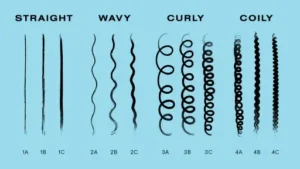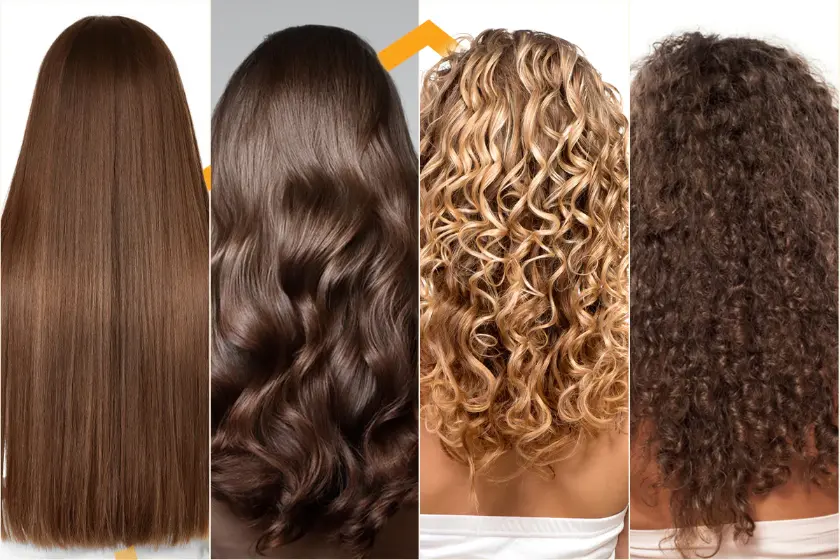Have you ever felt as though, despite all the products or styles you try, your hair just won’t cooperate? One basic reality is that knowing your hair type can help you identify that ideal hair day. Whether your hair is silky strands, wild curls, or textured coils, identifying hair type will enable you to control your hair care schedule. This tutorial will help you to identify your hair type, what it means for everyday care, and how to enhance your natural texture.
Hair Type Classifications
The first step, in determining your perfect hair type guide is identifying the hair type of the four main categories. These categories are widely accepted and provide a foundation for more precise classification.
Type 1 (Straight Hair)
Straight hair is sleek and smooth, reflecting the most light due to its uncurled structure. It’s often more resistant to frizz and easier to manage but can sometimes appear flat or limp. Type 1 hair does not curl naturally and tends to be oilier since sebum from the scalp travels down the strand more easily.
Type 2 (Wavy Hair)
Wavy hair, or Type 2, sits between straight and curly hair. It forms natural, S-shaped waves and can vary from loose to more defined waves. Perfect for many styles, wavy hair usually has more body and structure. It can be prone to frizz, though, particularly in humid conditions.
Type 3 (Curly Hair)
Curly hair has well-defined curls that bounce and coil. This hair type can range from loose curls to tighter ringlets. Type 3 hair often has more volume but is also more prone to dryness and frizz, as the natural oils from the scalp struggle to move down the hair shaft.
Type 4 (Coily Hair)
Tight curls or zigzag patterns identify coily hair—also known as kinky or textured hair. This sensitive and densely packed hair type requires minimal treatment to prevent breakage. Because natural oils are difficult to distribute along the length of the hair, oily hair is most prone to dryness even if it can have amazing volume and style possibilities.
Subcategories of Hair Types

Then, subcategories of hair type. Each of these main hair types has subcategories that further define the hair structure:
Type 2A, 2B, 2C: Looser or tighter waves with varying levels of thickness.
Type 3A, 3B, 3C: Loose curls to tightly packed ringlets.
Type 4A, 4B, 4C: Looser coils to tight, densely coiled hair.
Characteristics of Different Hair Types
After that, comes characteristics of different hair types. Knowing your hair type isn’t just about straight or curly hair. Other key characteristics come into play:
- Texture:Your hair’s texture falls into either fine, medium, or rough. While hair is stronger and thicker but may be more vulnerable to frizz and roughness.
- Porosity: There are three categories, hair porosity describes how well your hair absorbs moisture:
Low porosity: Hair is prone to product accumulation yet resists moisture absorption with tightly bonded cuticles.
Medium porosity: Because hair absorbs and stores moisture effectively, management of it is simpler.
High porosity: Hair absorbs moisture quickly yet is prone to dryness and frizz due to pores or cracks in the cuticle.
- Density: This describes the count of hair strands on your head, arranged thin, medium, or thick. While thinner hair could seem flat and may need volumizing treatments, dense hair usually has greater volume.
- Elasticity: Elasticity gauges the maximum stretch your hair may get without breaking. Your hair is more resilient if you have high elasticity; low elasticity may cause breakage and trouble keeping some styles.
How to Identify Your Hair Type
Next, Understanding how to manage and look after your hair correctly requires knowing its kind. Here’s how to get going:
- Visual Assessment: Simply observe your hair in its natural state—whether it’s wet or dry. Check for texture, wave patterns, or curl formation to identify the main category.
- Texture Tests: Take one single strand of your hair and roll it between your fingers to gauge texture. While medium hair will feel more solid, fine hair will feel thin and difficult to notice; coarse hair will feel thicker and weier.
- Porosity Tests: The float test is an easy way to measure porosity. Place a clean strand of hair in a glass of water. If it sinks immediately, your hair is highly porous. If it floats for a while, you have low porosity. Hair that slowly sinks to the middle indicates medium porosity.
Factors Influencing Hair Type
Several factors contribute to the hair type you have, including:
- Genetics: Your hair type is mostly inherited. Whether your hair is straight, wavy, curly, or coiled depends in great part on the shape of your hair follicle—round, oval, or elliptical.
- Ethnicity: Ethnicity often influences hair structure and type. People of Asian descent often have straight hair, those of European descent commonly have wavy or curly hair, and individuals of African descent frequently have oily or tightly curled hair.
- Environmental Factors: Your surroundings could determine the common state and texture of your hair. For those with curly or oily hair, especially, extreme humidity can induce dryness and frizz.
- Health and Nutrition: The condition of your hair also indicates your whole state of wellness. A diet high in minerals and vitamins—especially those encouraging hair growth (such as biotin and omega-3s)—can dramatically increase hair strength, elasticity, and general texture.
Care Tips for Each Hair Type
Identifying your hair type can help you choose the best products and treatments. Below are tips tailored to each hair type:
- Straight Hair (Type 1)
Product suggestions: Lightweight shampoos and conditioners to prevent oil buildup are the best hair type guide for straight hair.
Styling techniques: Use volumizing products to add lift and avoid weighing hair down.
Maintenance routines: Shampoo regularly to avoid greasy roots and condition the ends for hydration.
- Wavy Hair (Type 2)
Product suggestions: Anti-frizz serums and light mousses for added definition a good hair type guide for wavy hair.
Styling techniques: Scrunch your hair while damp to encourage waves; air dry or use a diffuser for gentle drying.
Maintenance routines: Opt for sulfate-free products to maintain wave structure without drying out your hair.
- Curly Hair (Type 3)
Product suggestions: Moisturizing shampoos, leave-in conditioners, and curl creams for wavy hair.
Styling techniques: Finger-comb your curls while moist, avoid heat
styling, and let hair air crisp to maintain a wrap pattern.
Maintenance routines: profound condition weekly to retain moisture and avert breakage.
- Coily Hair (Type 4)
Product suggestions: Heavy, moisturizing creams, oils, and butter.
Styling techniques: Protective styles like braids or twists can help retain moisture and prevent damage.
Maintenance routines: Hydrate daily with leave-in conditioners and oils to maintain hair health.
Common Misconceptions About Hair Types
Many people misunderstand hair typing and believe myths like “coily hair can’t grow long” or “fine hair is always thin.” Your hair’s growth potential depends on its health and care, not its type.
How Hair Type Can Change Over Time
Your hair type isn’t fixed in stone. Factors include hormonal changes, aging, or major changes in health, and food can change the texture and structure of your hair over time. For example, straight hair could get waves with age while once coily hair might lose its curl pattern after pregnancy.
The Importance of Knowing Your Hair Type
- Choosing Appropriate Products: Knowing your kind of hair will enable you to choose treatments appropriate for your particular need. One can considerably manage frizz, add volume, or define curls with the correct shampoo, conditioner, and style product.
- Effective Styling Methods: Hair types require different styling techniques. Knowing your type will guide you in choosing whether to air dry, blow dry, or use specific styling tools.
- Overall Hair Health: Your hair type will help you to preserve its health more successfully, thereby reducing frequent problems including breakage, dryness, and frizz.
Conclusion
Boosting your hair care program depends on first knowing your type of hair. This hair type guide helps you locate the ideal suit for your particular locks by dissecting the several classes and main features. Knowing your type—straight, wavy, curly, or coily—helps you choose the correct products and methods for daily healthy, vibrant hair.

